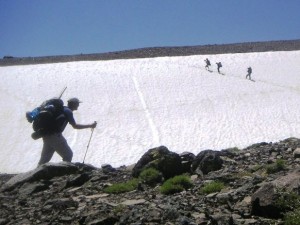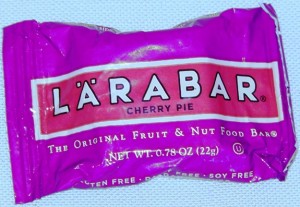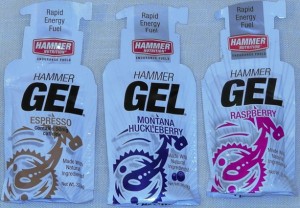The subject of food can be very complicated, or it can be fairly simple. It depends on what you are trying to achieve and how scientific you want to be.

Your daily caloric burn will fluctuate based on a variety of factors. According to the side of a box of cereal, US recommended daily allowances are based on an intake of 2,000 calories. While outdoor trekking your burn rate may be significantly higher depending on the the weight you are carrying, the distance you are carrying it and difficulty of the terrain you are carrying it over. A typical range for a summer trek may be 3,000 – 4,000 calories per day; for winter it may be closer to 4,000-6,000 calories per day.
For sake of argument, and we do like to argue, let’s assume a summer time daily burn of 3,500 calories. If your goal is to gain weight on the trek, you’ll have to carry more than 3,500 per day. If you are willing to lose some weight, you can go for a under 3,500 a day. The longer your trip, the more these daily loads of calories pile up and compete for your pack’s capacity for weight and space.
Food comes in some fairly standard forms: Carbohydrates, Proteins, and Fats. You may have determined, from your own experience or through consultation with your doctor, what you believe the optimal balance is. Recommendations vary widely. Here is a sample of some I have recently seen:
- Carbohydrates 60 % 50% 50% 40%
- Proteins 25% 35% 27% 30%
- Fats 15% 15% 23% 30%

If you don’t like these numbers, keep looking. You can pretty much always find someone recommending whatever you want.
You may find, however, that your opinion regarding optimal distribution while outdoor trekking may be different than your normal optimal distribution. Frankly, the difference comes down our old friends weight and bulk.
So how much does a calorie weigh?
It depends on the source of the calorie.
- 1 calorie of Carbohydrate = .25 grams
- 1 calorie of Protein = .25 grams
- 1 calorie of Fat = .11 grams
- 1 pound = 453.6 grams
Using these guidelines, to get to our target of 3,500 calories per day would require:
- In Carbohydrates: 3500 * 0.25 = 875 grams / 453.6 = 1.92 lbs
- In Proteins: 3500 * 0.25 = 875 grams / 453.6 = 1.92 lbs
- In Fats: 3500 * 0.11 = 385 grams / 453.6 = 0.85 lbs
Many of us have been taught to think that fat is bad, but in terms of calories to weight efficiency, fat is awesome.
Most foods we carry are not pure forms of carbohydrates, proteins or fats. They are usually a mixture of the three, and probably also contain water and fiber, which add weight but not calories. Food labels are a great way to help you compare energy to weight efficiencies.
Calories Per Ounce
Using some basic food items I had in my house, I calculated the calories per ounce using the following formula: grams per serving * .03527 = ounces per serving; calories per serving / ounces per serving = calories/ounce.
- Olive Oil – 261 (Serving labeled: 120 c / 13 g )
- Butter – 202 (Serving labeled: 100 c / 14 g)
- Peanut Butter – 168 (Serving labeled: 190 c / 32 g)
- Raw Almonds – 160 (Serving labeled: 170 c / 30 g)
- Ritz Crackers – 141 (Serving labeled: 80 c / 16 g)
- Wheat Thins – 128 (Serving labeled: 140 c / 31 g)
- Raman Noodles – 125 (Serving labeled: 190 c / 43 g)
- Quick Oats – 106 (Serving labeled: 150 c / 40 g)
- Fig Newtons – 100 (Serving labeled: 110 c / 31 g)
- Dried Mangoes – 97 (Serving labeled: 120 c / 35 g)
- Dried Cranberries – 92 (Serving labeled: 130 c / 40 g)
To hit a total of 3500 calories in:
- 2 lbs requires an average of 109.4 calories / ounce
- 1.5 lbs requires an average of 145.8 calories / ounce
- 1.0 lbs requires an average of 218.7 calories / ounce
Some backpackers take great care to figure out the calories per ounce of every food item they carry and create elaborate spreadsheets to track and balance the distribution by day, by meal and by category (carbohydrates, proteins and fats). How retentive you get in your approach is probably driven by how close to the limit of your weight and bulk capacity your trip plan is pushing you. For example:
If you are relatively healthy and traveling on a short weekend trip you pretty much have all the weight and bulk flexibility you need. You can still attempt to minimize weight by optimizing calories per ounce, but you risk giving up some significant food pleasure in the process. Unless you are practicing for some future longer ultra-light trip, enjoy yourself. Go ahead, throw in that subway sandwich, that fresh avocado, that box of Pop-tarts, that entire loaf of garlic bread, or whatever floats your boat.

As your trip plans get longer, however, weight and bulk do become more important. A 3-5 day trip may require that you start thinking about getting your pounds of food per person per day back closer to 1.5 lbs. As you can see from the above calculations, you are not going to be able to do that with just dried fruit and Raman.
If you push up the mileage and days of duration, you are probably going to have to take a serious look at ultra-light backpacking, where it is not uncommon to target closer to 1 lb per person per day.
To get to this level of efficiency takes some serious planning and calculation, not only by increasing the fat content in your food, but by optimizing in every area. For example, if you carry foods that do not need to be cooked, you can save on the weight of stoves, fuel and pots. Carry a lighter tent and a lighter bag, and you will burn fewer calories and therefore need less food to replenish.
Whatever your food strategy, paying closer attention to calories per ounce can be eye opening. Clarified butter, oil, peanut butter and Nutella just may move up a notch on your food chain.
